|
Chapter 5
PERU
Puerto Maldonado - Cusco -
Pisco
A
little further on, at the bottom of a huge tree which was apparently
their home, the monkeys
joined us - large black spider monkeys with long legs and tail; small
creamy coloured capuchins and tiny black ones with coloured backs and
funny faces and a name that sounded like “screwy”.
Are there screwy monkeys? We
all spent some time feeding the monkeys and the coatis and taking lots
of photographs. The animals
had obviously done this before and were “almost” tame.
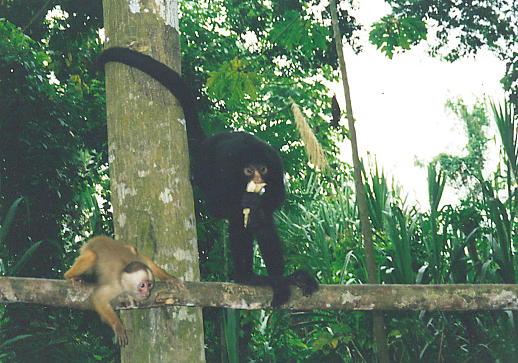
After
leaving the monkeys we continued walking through the jungle to a huge
beach where the sun was setting. Flavio
whistled for the boat to come back across the river to collect us.
The boatmen were playing football and it took a little while to
attract their attention.
When
night fell small kerosene lamps were lit every two metres down the
walkway and around the huts and each hut was given a lamp.
There was a chap called Tomas whose job it was to light the
lamps, instantly re-christened “the lamplighter” by Jen. Each table in the dining room had a candle but it was still
fairly dark. We saw no sign
of electricity but there were two fluorescent strip lights fixed to the
dining room ceiling although they were never used whilst we were there.
After
cena (dinner) we took a boat to see the cayman (crocodiles).
This time our boat had no cover and was powered by a Briggs and
Stratton “peque-peque” seven horsepower engine.
We motored up river for a bit and then came back under Flavio’s
and another chap’s paddle power. Everyone had torches except Jen and I, my feeble torch had
given up and hers was stolen in Santiago.
We were quite happy watching the stars and letting other people
find the crocodiles. Jen
and I were told off for being noisy - we would frighten the crocodiles
away (they could be very officious these Peruanos).
It was delightful floating back down the river and we did see
several cayman (or should that be caymen?).
We
sat by the harbour for a bit discussing the night sky, about which we
knew nothing, and then went to bed.
By 2200 everything was closed for the night.
Monday
20 July
We
were woken at 0500. Breakfast
was at 0530 and we were not allowed to miss it.
The walk started at 0600. Only
Flavio was with us that day and although he was a little darling he
spoke no English so the commentary passed us by.
Jen and I amused ourselves by making up our own commentary which
got wilder and wilder and funnier and funnier.
Lots of the trees and plants had medicinal uses and effects so we
had plenty of scope for our imaginations.
Then an irate Flavio came up and let loose a string of Spanish
except we didn’t understand what he was saying.
One of the Argentinians who were with us on the walk had to
translate. We were being
told off. “Keep quiet so
you can listen to the birds.”
Jen
and I already had the impression, by the way we were ordered around,
that we were back at school (we went to the same one although several
years apart) and this latest telling off just confirmed it.
We reverted to schoolgirlhood.
We had a really hard job not laughing and tried dropping behind
the rest of the group so we could talk and laugh freely. This didn’t work as Flavio kept stopping to talk about one
of the trees or plants and waiting for us to catch up, scowling
furiously. This made us
laugh all the more. Oh
dear! [It
has been pointed out to me that my comments about other people’s loud
and irritating voices may well be applied to me at this point, and the
previous night, but I don’t believe it!]
We
walked for several hours and got back into Flavio’s good books by
paying attention and asking intelligent questions.
There were lots of bird noises - we could ask what they were but
the names meant nothing to us. Flavio
could often describe them - for example, small and brown - but that was
all.
We
stopped at a mirador for bananas, Jen doesn’t eat bananas.
A mirador is a viewpoint and, on this occasion, was a raised
wooden platform on which you could sit and contemplate the jungle.
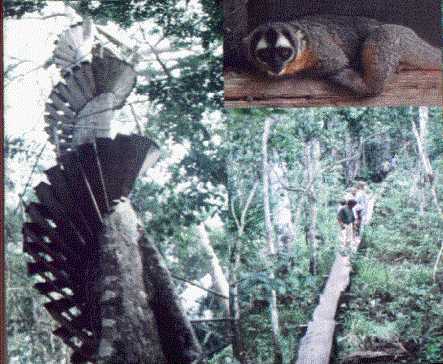
Part
of the EcoAmazon brochure
There
were two very tall mirador trees with wooden stairs built around them
but I knew I couldn’t climb them without throwing a wobbly halfway up
so Flavio and I discussed my Spanish phrase book, he wanted to learn
English, whilst the rest climbed and photographed.
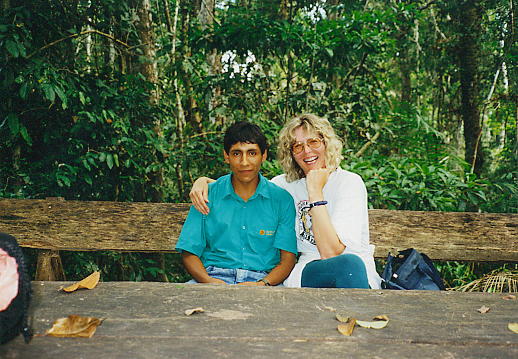
Flavio
and I - we were speaking by now.
The
walk was mainly along one path although we did encounter other paths
occasionally. Particularly
boggy or wet bits had raised walkways.
Flavio talked of the trees, lianas, animals and insects but not
much of the flowers, butterflies or fungi.
At one point a wild pig ran away from us but we didn’t see it. Quinine trees towered above us, surpassed only by the Tahuari
hardwoods, trees so tall and solid that jungle shamans describe
themselves in terms of their power.
Around their trunks you could see pega-pega, a parasitic ivy-like
plant that the shamans mix with the hallucinogenic Ayahuasca.
One thin species of liana vine can be used to take away the pain
from a shushupe (a bushmaster snake) bite.
Another, the maravilla or palo de agua, issues a cool stream of
fresh water. Jen and I
wanted to know about everything that was different or unusual.
After
the mirador trees there was a long walkway over a waterlogged bit, with
water lilies, not in flower, and tiny fish, to the lost lake.
We came to an open canoe like boat.
We all climbed in and Flavio paddled us around the lake.
There were caymen and spectacular dragonflies.
It was nice to be out in the sunshine and, again, very tranquil
being paddled on the water.
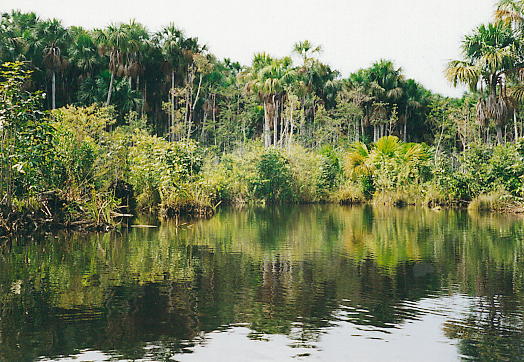
The
lost lake
Then
we had the long walk back past termite nests, which they feed to the
chickens. The walk was
mostly flat and it was hot but not unbearably so.
Flavio set a cracking pace and had to keep waiting for us all.
We were all hot and sticky by the time we returned home at 1345.
After
lunch we took another boat trip to a local family’s house.
A man and woman and five children from one to eight.
They grew coconuts, bananas, pineapples, maize and cucumbers.
They had two adult dogs, one wet puppy (I don’t know why it was
wet) and some tiny puppies, just born, as well as a chicken (eating a
termite nest) and a duck. They
lived in a tiny hut with two beds, a fire and a radio.
The little boys played football and the family were happy to show
us around.
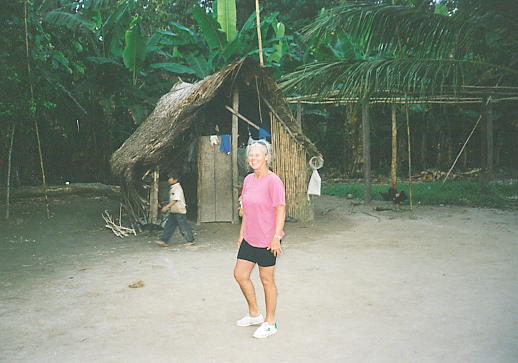
Jen
and I had to go to the dining room for cards before dinner as that was
the only place with enough light to see the cards.
After dinner there was a walk in the jungle by night.
As Jen and I did not have torches negotiating the raised walkways
was a little hairy. Flavio was in front with one Argentinian girl holding his
machete and the next girl holding her hand, then Jen and I, two
Americans (whose conversation about their exploits kept us amused
although I don’t think they intended it that way) and Jesus and his
wife. Fortunately the
Americans had torches and we managed without breaking our necks.
At the end there was a mirador where we could sit and listen to
the cicadas, frogs and birds in the jungle at night and watch the
amazing fireflies. On the walk back Jen and I discussed teachers we had both
known, we were allowed to laugh by now.
Tuesday
21 July
We
were woken at 0500 again. We
had to catch the same plane back as brought us out and it was more than
1½ hours down river to the airport.
As we approached Puerto Maldonado it rained but it was only a
passing shower. One hill in
Puerto Maldonado had been turned from dust to mud and was causing
difficulty for the traffic. At
the airport we were presented with our tickets but we needed S20 airport
tax and we had S11.50 between us. EcoAmazon
representatives seemed unable or unwilling to help so Jen borrowed S20
from a German who was staying in Cusco.
At
San Blas we were welcomed as old friends and rented our third room,
larger and further along the corridor upstairs from our first. After repaying the German we spent the afternoon trying to
find a bus to Pisco. All
the travel agents said it was not possible.
Eventually the Tourist Information Office sent us to Arcopata (a
street in Cusco) where Wari (a bus company) went to Pisco twice a day
for S55 (£14.86). We
couldn’t book because San Blas junior was going to see what he could
find out but when we returned to San Blas he suggested a couple of bus
companies, their offices were in San Francisco (another street in Cusco)
and the buses went from Arcopata.
We
spent the afternoon at Jen’s favourite hostel - another Ima Sumac -
with the sauna and steam room. Lovely.
I’d forgotten how clean you feel afterwards and as we didn’t
fancy a brownish cold shower in the jungle we needed it.
My hair was like straw. Then
we had to walk back up to Arcopata on the outskirts of the city (we were
too mean to use taxis) to book our tickets and our friendly bus lady had
been replaced by a younger woman who denied there were any buses to
Pisco at 0700 the next day. We
argued but she was adamant. We
ended up buying tickets to Abancay, the first town on the road to Pisco.
We would work out how to do the next stage when we got there.
We walked past a pizzeria on the way and decided to call in for
dinner. Whilst studying the
menu Jen pointed out they served guinea pig so we had that and heart
kebabs and swapped halfway. Cuy
was sweet, small and bony.
We
had our last coffee at the cafe in San Blas plazolita and discovered
that a Belgian had bought all the wall hangings.
We should have bought one when we had the opportunity.
Our Lima friend tried to persuade us to join him and his friends
on a mountain biking trip the next day but it was time to move on.
Wednesday
22 July
We
arrived at Arcopata well before 0700 after moving farewells from San
Blas senior. The original
woman was there - why weren’t we going to Pisco?
Unbelievable. We
changed our tickets and got on t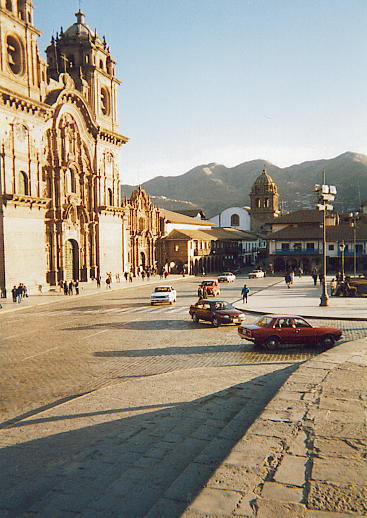 he bus.
Over the mountains, miles of bends, dirt roads, after four hours
we could see Abancay in the valley but it took more than another hour of
winding hither and thither to get there.
At Abancay we were told the bus left again at 1500 after a 2½
hour stop. We amused the
locals by exploring the town and returned to the bus stop in plenty of
time. No bus.
The two chaps in the office appeared to know nothing apart from
the fact that the bus was somewhere else.
We managed to find out where and a taxi took us there for S2.
Jen thought the bus driver would have gone back to the original
stop for us but we’ll never know.... he bus.
Over the mountains, miles of bends, dirt roads, after four hours
we could see Abancay in the valley but it took more than another hour of
winding hither and thither to get there.
At Abancay we were told the bus left again at 1500 after a 2½
hour stop. We amused the
locals by exploring the town and returned to the bus stop in plenty of
time. No bus.
The two chaps in the office appeared to know nothing apart from
the fact that the bus was somewhere else.
We managed to find out where and a taxi took us there for S2.
Jen thought the bus driver would have gone back to the original
stop for us but we’ll never know....
We
followed the Apurimac river looking out for white water rafting spots
until it got dark. After
our rafting adventure we were offered a trip on the Apurimac river, this
time for three days. The
Apurimac is even more exciting than the Urubamba but we decided we
didn’t have the time. The bus went over two passes above 4000m.
Occasionally by the light of the moon I could see the single dirt
track road with steep hills on one side and sheer drops on the other.
There were problems if we met something coming the other way and
one vehicle would have to reverse until a passing place was found. Dinner
was somewhere en route, we were the only gringos in town and stunned the
other diners in the restaurant. We reached the Pisco turning, after 26½
hours on the bus.
Thursday
23 July
We
had to take a collectivo to Pisco town from where we were dropped off on
the Panamerican Highway. Damn
the expense we’ll have a baño privado (private bathroom).
Jen crashed so I explored. The
market obviously hadn’t seen a gringo in a while.
Having
quartered the town I took a last walk down a street off the Plaza.
Some chaps sitting outside a restaurant stopped me and insisted I
join them for a drink. Bacardi Limon and Canada Dry.
Peter, Charlie and two otros (others).
Peter worked at the Aduana (Customs) and was the boss.
They had a half day. Afterwards
we went to San Andreas (the nearby port) for a fish lunch.
Another girl had joined us by now, the girlfriend of one of the
others. The first course
was little pieces of fried fish - corvina - with bright yellow chili
sauce. I wasn’t hungry but they insisted. Cristal cerveza (lager) was served but I mentioned Cusqueña
(a different sort of lager) so I was bought 1.1l of the stuff for
myself. The second course
was fried corvina with chips and rice.
I had to pass on this as I really wasn’t hungry but as the
other girl did too, this was allowed.
The four men tucked in. Peter
drove me back to Pisco and suggested a little whisky at his place, his
wife was dead and his children were grown up and married in Lima but
“I only popped out for a little while and Jen will wonder where I
am” - what a wonderful excuse.
We
had empanadas for dinner followed by Pisco Sour (a concoction of the
local brandy and lemon juice) at the local restaurant (part of our
hostel) with Ruben, the owner who spoke a little English, and some
Austrians. Ruben was
actually a fisherman from the north of Peru but “El Nino” had made
the water too warm for the fish so he was staying in Pisco temporarily,
running his mother’s restaurant.
His wife and children were due to join him at the weekend and he
could not resist showing all the customers in his restaurant photographs
of his family, several times! He also had a collection of coins from around the world and
we saw that several times too.
Friday
24 July
Our
trip to the Paracas Nature Reserve.
We took a bus to the harbour and then a motorboat to Islas
Ballestas via the Paracas Trident, a massive 128 metre high by 74 metre
wide candelabra carved into the hillside.
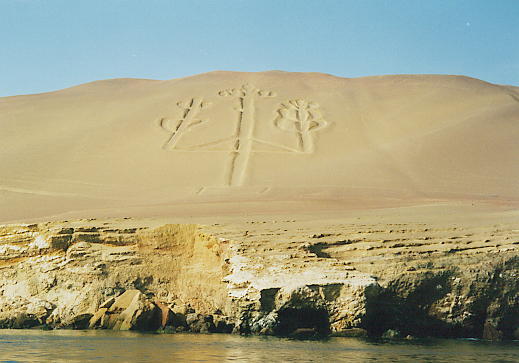
No-one
knows its function or its creator.
Eric Von Daniken speculated that it was a sign for
extra-terrestrial spacecraft, pointing the way (inaccurately) to the
Nasca lines; others suggest it was constructed as a navigational aid for
eighteenth century pirates. However,
it seems likely that it was a kind of pre-Inca ritual object,
representing a cactus or tree of life and that high priests during the
Paracas or Nasca eras worshipped the setting sun from this spot.
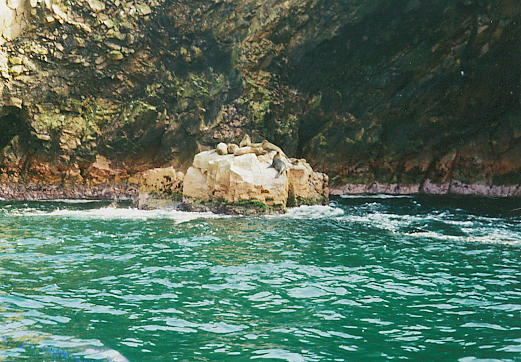
Just
a small sample of the many sealions
On
the, uninhabited, islands we could see pelicans, boobies, Peruvian
terns, turkey vultures and masses of sealions.
The bus toured around the park, not so much a park more a desert.
At the small village of Lagunillas we had lunch of
mixed ceviche (raw fish marinated in lemon or lime juice) and
fried polpo (octopus), neither of which we particularly enjoyed.
We had a short time on the beach instead of visiting the museum. Juan, our guide, said we had ten more minutes and two minutes
later was ordering us to jump to it and return to the bus which was
revving up in the car park. These
officious Peruanos again. And
we weren’t being loud this time!
Saturday
25 July
My
day out. I took a bus to
Ica, about an hour down the Panamerican Highway.
I was heading for the Hotel Las Dunas which was the only place
around here to offer horseriding. My
seat companion on the bus was a young Peruvian girl called Julie who
spoke a little English. She
offered to show me where to get off for the Hotel Las Dunas and, when it
came to the time, she alighted with me.
We walked up the road and entered the hotel grounds.
It was extremely posh with rooms starting at $80 (£50).
As a gringo I had no problem passing the guard at the gate.
Julie had to show her card, she was a travel agent, as it
happened!
We
walked through beautiful grounds with new, white, two storey habitacions
and lots of brilliantly coloured bougainvillaea, to the corral.
Julie took over the discussion and informed me that there might
be riding at 1430 if there were two other people from the hotel.
We
left and took a moto (one of the little taxis with a scooter front and
two covered seats behind) to Huacachina.
During the late 1940’s Huacachina, 6km southwest of Ica, was
one of Peru’s most elegant and exclusive resorts, with a lagoon
surrounded by palm trees, sand dunes and waters famed for their curative
powers.
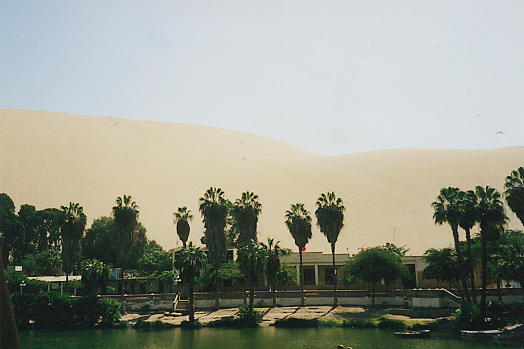
Huacachina
- if you can see any dots on the hillside they are surfers!
Sand
dune surfing on the higher slopes was all the rage and you could hire
wooden boards from the cafes along the shoreline.
Julie and I passed the time here quite happily, drinking coffee
(well, she drank Inka-Kola, a locally made, sweet, yellow fizzy drink),
walking around the lagoon, looking at all the artesanal stalls and
having chicken sandwiches whilst closing our ears to the, extremely
loud, singer and band. I
discovered they have dressage - caballo de paso - meetings around here
after the harvest in March. All
the time we talked in broken Spanish and broken English.
At
the appointed time we returned to Hotel Las Dunas. No-one had arrived to ride yet but there was still time and
if no-one turned up I could ride around the paddock on my own.
After 20 minutes Luis arrived from the hotel.
He owned a hotel in Lima and came here every year at this time.
Although this was not three people the man in charge of the
horses agreed to go out. I
was given a chestnut horse which wanted to go in every direction except
the one I wanted. Luis had
a large bay and the guide, a grey mare.
We
exited the hotel grounds and on the road outside the guide indicated
that we should change horses. The
grey mare wished to be in front. If
she heard a horse behind speeding up she sped up even faster. We walked down a couple of roads and across a field that used
to contain maize. Then we
reached the sand dunes. I
had one of the comfortable Peruvian Western type saddles and wooden cup
stirrups which taught me very quickly where to put my foot and how to
keep it there. At the first
sand dune we cantered off and after that it was just sand and speed.
My horse was thin but very fit.
She had a bitless bridle and obviously I could yank to stop her
but I was content to direct her from right to left.
Amazing. It was a
hot, sunny day and the sand dunes were beautiful.
We flew up dunes and then down the other side.
Luis wanted to go for it and this encouraged my horse to compete
with his and beat his on every occasion.
What a wonderful feeling.
When
we turned for home we were instructed to walk the horses as the guide
would get into trouble if he returned them looking hot and sweaty.
This was difficult as my mare did not understand “slow” but
we managed it. At the gate
of the hotel I had to change horses again, apparently gringos were not
allowed to ride the grey mare. After
dismounting I tried to take a photograph of the grey mare but my camera
just made nasty crunching sounds and refused to work. Thinking about it afterwards, I was quite surprised that,
despite the heat, on all three occasions when I went riding there were
no flies.
Julie
was waiting by the corral. She
had explored the hotel grounds whilst I had been away and showed me the
menagerie on the way out - several different types of parrot, a
chinchilla, an iguana and one monkey who spent all his time bashing the
floor with his food dish. As
his cage was bare, no branches or greenery to be seen, I was not
surprised he was manic.
Once
back on the main road we had a choice - go to Ica and visit Vista
Allegre (a winery) or go to another winery that Julie knew. Hers was on the road to Pisco so this seemed a good idea.
All we needed was a moto going in the right direction.
We waited for a moto. It
was getting late and in the end we gave up and took a taxi to La
Catedral, a wine and pisco manufacturer.
We were shown round the winery by Carlos who didn’t seem to
work there but was very knowledgeable. As it was winter the vines were bare, nothing was happening
and everywhere looked very dusty and unused.
Their busiest time is in February and March. Pisco appears to be distilled
Chapter
6
Top of page
Home |